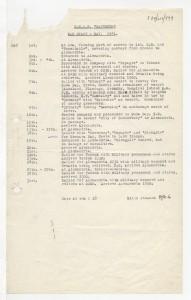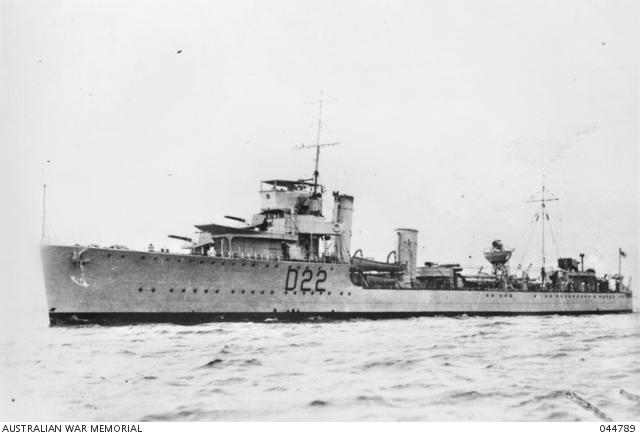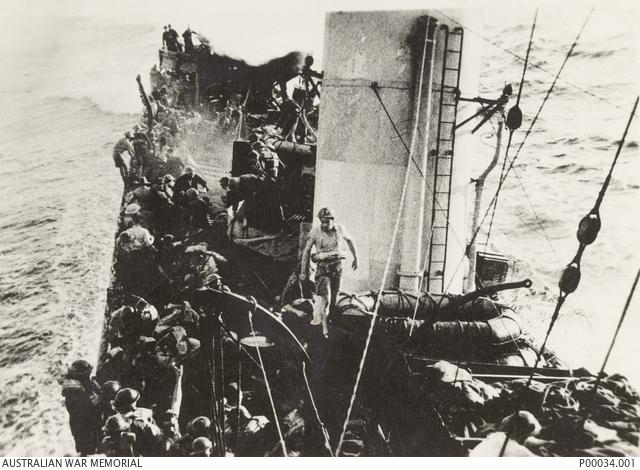Reports of Proceedings: The Tobruk Ferry and HMAS Waterhen
The ongoing project to digitise AWM78 Reports of Proceedings, HMA Ships and Establishments has now reached 46 341 images. The reports of proceedings for seventy-nine ships are now available on the Memorial’s website. This includes all of the destroyers employed in the Tobruk Ferry. Some of the ships that were later involved with the Tobruk Ferry, HMAS Parramatta and HMAS Yarra, have also been digitised. These files can be viewed online.
May 1941 saw the commencement of the Tobruk Ferry Service to transport troops, supplies and ammunition between Alexandria and Tobruk. The Tobruk Ferry employed the destroyers of the 10th Flotilla (HMAS Stuart, HMAS Vampire, HMAS Vendetta, HMAS Voyager and HMAS Waterhen). Other Mediterranean ships also became involved from August 1941.
Running to a regular routine, the service began on 5th May 1941 with a successful round trip completed by HMAS Waterhen and HMAS Voyager. This voyage was described in Waterhen’s report of proceedings for May 1941. This report illustrates the function of the service as well as the speed of turnarounds:
5th Proceeded in company with “Voyager” to Tobruk with military personnel and stores.
6th Arrived Tobruk at 0230. Sailed for Alexandria at 0430 with military wounded and details being relieved. Arrived Alexandria 1900.

Whilst the ships navigated the distance between points of arrival and departure, it was expected that they would be attacked by the enemy. Sadly, it was these attacks which brought an end to the career of HMAS Waterhen.

Waterhen sailed from Mersa Matruh on her 13th run to Tobruk during the afternoon of 29 June 1941. Weighed down by 50 tons of stores and carrying 70 troops, she was accompanied by HMS Defender who bore a similar cargo. Both ships were attacked by a squadron of 15 dive bombers off the coast near Salum at 7.45pm. The Defender was attacked first but emerged from the encounter unscathed. The first bomb aimed at Waterhen exploded in the water behind her but resulted in the ship becoming unresponsive to the helm. Three more bombs resulted in the flooding of the engine and boiler rooms. The final attack brought damage to the engine room, the engineer’s cabin and the central store. Defender responded to Lieutenant Commander Swain’s decision to abandon ship and came alongside the stricken ship to remove everyone on board.


It was decided Defender would take advantage of nightfall and tow Waterhen into Mersa Matruh before dawn. During the ensuing preparations, the rising moon highlighted a submarine lying nearby. Shells were fired and the submarine crash dived with Defender in pursuit. After losing contact, Defender returned to where Waterhen was waiting and the tow commenced.
By 11pm it was evident that the listing to port was increasing and Swain decided to abandon the tow. Some men had re-boarded the Waterhen for the tow and they were all brought back to Defender where they watched and waited for the ship to sink. At 1.50am on 30 June 1941, the Waterhen, or “Chook” as she was warmly referred to by her crew, rolled over and sank. She was the first ship of the Royal Australian Navy to be lost by enemy action in the Second World War.
Although the official report of proceedings for June 1941 was never filed for Waterhen, having gone down with the ship, anecdotal stories and eye-witness accounts of the event do exist. The sadness of the event is very much evident in the ten pages devoted to the loss of the Waterhen in the diary of Andrew Robert Nation. Lieutenant Commander Ean Lawrence McDonald recalls how he was so engrossed in photographing the incident that he forgot his belongings were going down with the ship. He recounts his experience of retrieving his case of photographs from below deck and laments that he never found the fancy French cakes that he had taken on board. Remarkably, there was only one other casualty – a rating who was struck by a tin of peaches.
More information
Lind, L.J. and Payne, A., Scrap Iron Destroyers: The Story of HMA Ships Stuart, Waterhen, Vampire, Vendetta and Voyager, Garden Island, 1993.
HMAS Waterhen Reports of Proceedings September 1939 – May 1941, Australian War Memorial, AWM78 362/1.
Papers of McDonald, Ean Lawrence, (Lieutenant Commander, b: 1918), Australian War Memorial, MSS1081.
Papers of Nation, Andrew Robert (Stoker Petty Officer Mechanic b: 1920), Australian War Memorial, PR00186.
Gill, G Herman, Royal Australian Navy, 1939-1942, Australia in the war of 1939-1945, Series 2 (Navy), vol. 1, Canberra, 1957.